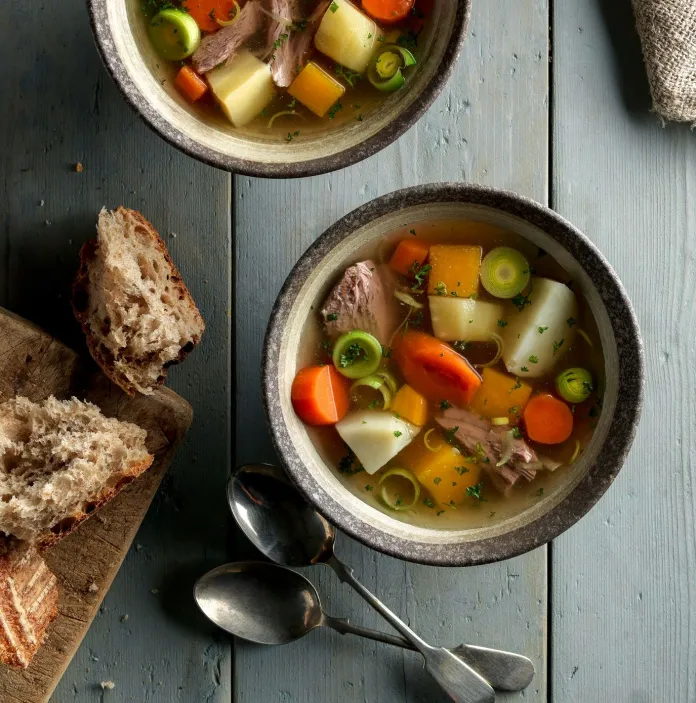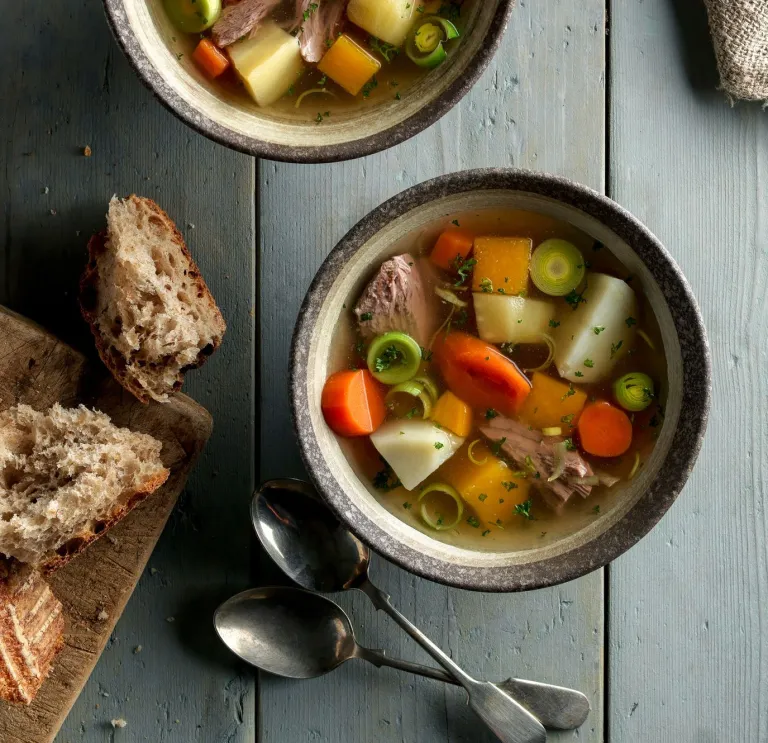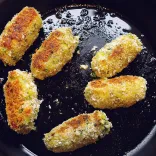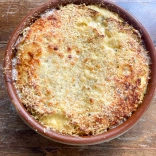Often crowned, unofficially, as the national dish of Wales, cawl is a warming, hearty broth of meat and seasonal vegetables that has been rustled up in Welsh kitchens for generations.
Known as lobsgows in North Wales, cawl was, traditionally, more commonly served in two courses, with the broth coming first and the chopped meat, potatoes and vegetables served second. Today, however, it is enjoyed as a single, all-encompassing meal, with lamb a favoured meat and leeks often featuring alongside potatoes and other seasonal veg.
Though the exact recipe for cawl would vary from town to town (or even house to house!), the key to a good cawl, according to the Welsh poet and medieval scholar Iolo Morganwg, is that it should be ‘as good to drink the broth as to eat the meat.’ Cawl is best served with chunks of warm bread and, ideally, a slathering of Welsh cheese.
When is it eaten?
Welsh cawl is usually eaten at lunch or dinner, particularly during the winter months, when this warm bowl of goodness is an excellent antidote to the frigid weather. It is often better the day after preparing when all the flavours have developed. The dish is a regular fixture on special St David’s Day menus, put on by Welsh restaurants around March 1, the feast day of Wales’ patron saint.
Notes from the chef
While it’s considered one of the iconic dishes of Wales, traditional recipes for cawl tend to vary significantly, with the ingredient list seeming to alter depending on what meat and vegetables were readily available at the time. For my recipe, I’ve kept things classic by choosing lamb as the meat of choice, but feel free to experiment. Keep in mind it is generally accepted that slow cooking cuts, such as neck on the bone, will bear the best results.
Early recipes of the dish dictate that the meat and vegetables should be simmered together in the pot without browning the meat first. This would have largely been due to the practical capabilities of rural home kitchens. Following the lead of the Welsh culinary authority Bobby Freeman (who published the pioneering guide to Welsh cooking First Catch Your Peacock), I’ve chosen to brown the meat in my recipe.
Lamb neck and smoked pork hock is a very good combination if you fancy trying a mixed meat cawl. If opting for this, follow the recipe below, but when browning the lamb neck, bring the smoked pork hock up to the boil in a separate pan of water. Let it gently simmer for five minutes before removing from the heat and discarding the water. This will ensure the hock is not too salty and that the smoked flavour is not overpowering. Now add to the cawl pot with the lamb neck once the onions have been sweated then proceed as the recipe below dictates. But taste the broth before you add any salt as the smoked hock will likely be salty enough.

How to make Welsh cawl
Serves: 4 (6 if you add an additional hock) | Prep time: 20 minutes | Cook time: 3.5 hours
Ingredients
1 tbsp vegetable oil, lard or dripping
800g piece lamb neck on the bone
2 onions, finely diced
A bundle of 4 thyme sprigs, 2 bay leaves and 2 rosemary sprigs
3 carrots, peeled and cut into 1 cm rounds
2 leeks, white part cut into 2 cm rounds and the green tops finely sliced
1 small swede, peeled and diced
2 potatoes, peeled and cut into 8
Salt and freshly ground black pepper
Method
Step 1: Heat the oil in a large pot over a medium heat and add the lamb. Cook for 5 minutes or until brown on all sides, remove from the pan and add the onions and sweat for 5 minutes until translucent.
Step 2: Return the lamb to the pan and add enough cold water to cover the lamb by a few centimetres (approximately 1.5 litres), as well as the herb bundle. Bring to the boil and then reduce to low heat and gently simmer for 90 minutes, skimming off any scum that rises to the surface.
Step 3: Add 1 teaspoon of salt and black pepper to taste followed by all the veg, except the greens of the leeks, and simmer gently for another 60-90 minutes, so that the meat and vegetables are all tender.
Step 4: Lift the meat from the pot using tongs and remove the meat from the bones. Dice into large chunks and return to the broth along with the green tops of the leeks and simmer for a further 5 minutes. Adjust seasoning as desired. It is commonplace for cawl recipes to recommend leaving the soup overnight as the flavour will develop and improve, but I’ll leave that up to you!
Step 5: Serve your cawl with curly parsley sprinkled over the top and a side of crusty bread with Caerphilly cheese.
This recipe was researched and tested by chef Alex Vines. Alex developed his signature “simple yet attentive” cooking style during a decade working in renowned London restaurants. Originally from Cardiff, Alex champions the use of seasonal and local produce, mirroring the principles of traditional Welsh recipes. Follow Alex on Instagram.


